Theme Colors are one of the 4 theme components mentioned in the previous article. Using this feature is an ideal way to change how your projects or courses look. So, in this article, you will learn how to work with theme colors in ActivePresenter 9.
Let’s explore:
Overview of Theme Colors
ActivePresenter 9 provides you with many ready-made theme colors. You are free to apply them to your project. Besides, the app allows you to create your own one.
To access the theme colors gallery, open the Design tab > Colors. Take a look at the image below for details:
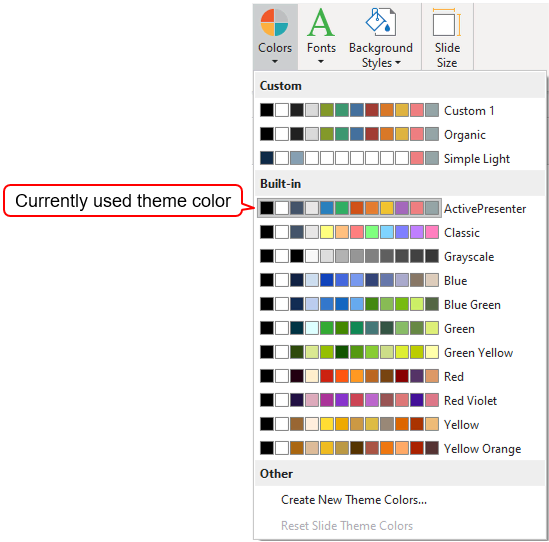
As you can see, the gallery includes three sections:
- Custom: Contain the theme colors you’ve created.
- Built-in: Contain ready-made theme colors.
- Other: Allow you to create or reset theme colors. See the next part of this post for information.
The currently applied theme color is highlighted with a gray outline. Basically, a theme color is a set of different colors in which the first four colors (from left to right) represent text and background colors (light and dark for each). Meanwhile, the rest illustrates six accent colors for objects such as shapes and images.
Note: You can hover the mouse over any theme color in the gallery to preview how they change the look of your slide.
Apply and Manage Theme Colors
Now, keep reading to find out how to work with theme colors by applying and managing them.
To apply a theme color, select your slide(s) > open the Design tab > Colors > select the color set you want. Then, ActivePresenter 9 will apply the new theme color to all slides that share the same slide master as the selected slide(s).
To have more options, right-click a theme color and select one of the following:
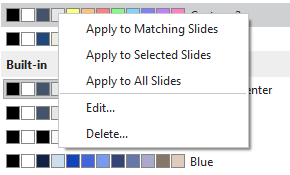
- Apply to Matching Slides: Apply to all slides that use the same slide master as the current slide. It works as you left-click to select a theme color.
- Apply to Selected Slides: Apply to the selected slides only. If the new theme color doesn’t please you, click Reset Slide Theme Colors to discard the change.
- Apply to All Slides: Apply to all slides in your working project.
- Edit…: Modify the selected theme color. This option is available for custom theme colors only.
- Delete…: Remove the selected theme color. After that, it will disappear from the theme colors gallery. This option is available for custom theme colors only.
Create New Theme Colors
Steps to Create New Theme Colors
ActivePresenter 9 allows you to create a new theme color. Do as follows to perform this task:
Step 1: Open the Design tab > Colors.
Step 2: Select Create New Theme Colors… Then, the Create New Theme Colors dialog appears like the image below:
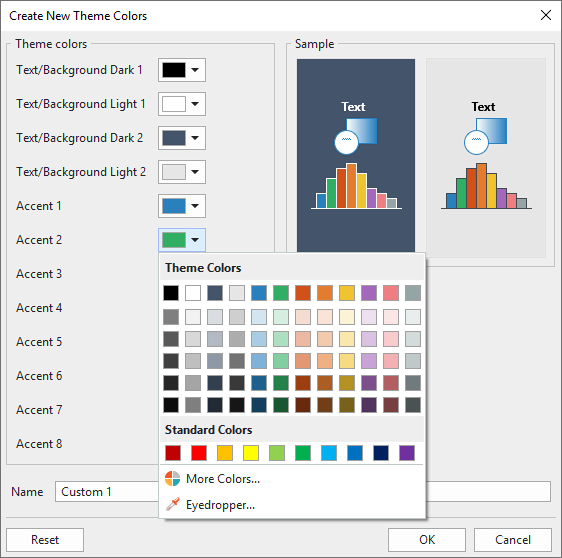
The dialog has two main sections:
- Theme colors: Consist of 12 current theme colors. Each includes 4 text/background colors and 8 accent ones. Click the color dropdown lists to set the colors you want.
- Sample: Preview the changes you make in both dark and light UI.
These color choices also determine preset colors available when you select fill and outline colors for objects. So, be careful!
Tip: When specifying colors, especially accent ones, it’s better to look at the Sample box. This box gives you a preview of changes. So, you know how a color looks next to another in a column or bar chart.
Step 3: Enter your desired name for the new theme color in the Name box.
Step 4: Click OK to save and close the dialog. Then, the newly created theme color will appear in the Custom section of the theme colors gallery. After that, you can apply it to your current project or reuse it later.
In case you wish to restore the original theme color, click Reset.
Note: ActivePresenter saves custom theme colors in C:\Users\\AppData\Roaming\ActivePresenter\themes\colors (for Windows) or /Users//Library/Application Support/ActivePresenter/themes/colors (for macOS). From here, you can:
- Rename theme color files.
- Delete any theme color file. Then, they no longer appear in the theme colors gallery.
- Share and reuse theme color files.
If you can not find this folder, turn on the Show hidden files, folders option to see it.
Things to Remember When Creating Theme Colors
Additionally, pay attention to the following notes to create an ideal theme color.
As mentioned above, each theme color includes 4 text/background colors and 8 accent ones. Once you have already created a custom theme color, the Color Picker will have new tints and shades automatically created by ActivePresenter 9. It’s impossible to control how tints and shades are defined. But you can adjust them by clicking More Colors. Note that shades and tints can be slightly different, depending on the used theme color.
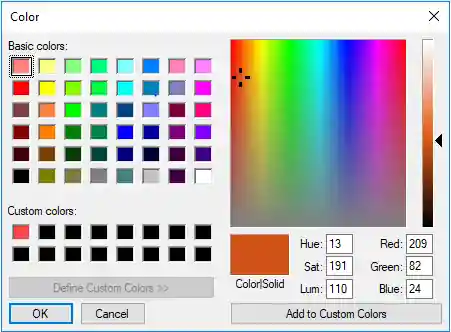
Besides, the order of 12 colors is crucial. The order of text and background colors defines which color will be used as the default text color and default background. Dark 1 and Dark 2 should always be dark colors. Likewise, Light 1 and Light 2 should always be light colors. With these in mind, keep black and white among the first four text and background colors.
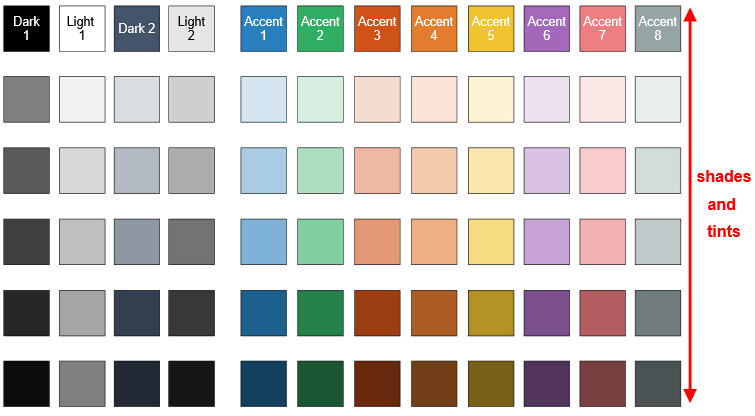
Tips:
- Select 12 colors for the new theme color carefully. Also, you should choose eight distinctive colors for your accent ones, and they are different from the four colors for text/background.
- You’re free to choose any color for text and background besides black and white. But you should choose text colors that contrast well against background colors to ensure that the text is visible on the background.
- When specifying colors, especially accent ones, it’s better to look at the Sample box. This box gives you a preview of changes. So, you know how a color looks next to another in a column or bar chart.
Edit Theme Colors
Apart from creating new theme colors, you can also edit existing custom theme colors. Do as follows to have it done:
Step 1: Select Colors in the Design tab.
Step 2: Right-click the theme color you want to edit > Edit. After that, the Create New Theme Colors dialog appears. Do the same steps as creating new theme colors.
That’s how to work with theme colors in ActivePresenter 9. Let’s download the latest version of ActivePresnter and create your project.

Visit our Tutorials page, and YouTube channel to get more handy content. If you need any help, feel free to contact us.
See more: